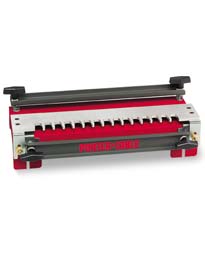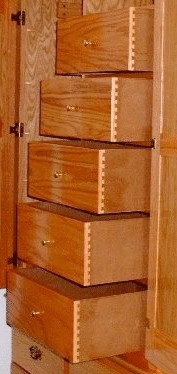|
Page Directory
Introduction
What I Like
What I Don't Like
The Bottom Line
Assembly
Setup
Making a Drawer
Tips
Guide Bushings
Stabilizer Table
Print Friendly
Site Directory
Home
Tool Reviews
Projects & Plans
Articles
Our Shop
FAQs
Sites I Like to Visit
Build a Kayak
E-Mail Us!
|
|
 A single purpose half-blind dovetail jig like the PC 4112 makes sense for those who want to make drawers and boxes
employing half-blind dovetails without a lot of fuss. The jig is solid and produces a perfect half-blind dovetail
joint everytime. If you're looking for a small production jig, the PC 4112 should suffice. If you plan on making tons
of drawers day in and day out, consider the PC 5116 or PC 7116. These later jigs have cast iron bases and cam operated
clamp bars. They employ a similar aluminum template as the PC 4112. The 5116 template accomodates widths up to 16" and the
7116 template accomodates widths up to 24".
A single purpose half-blind dovetail jig like the PC 4112 makes sense for those who want to make drawers and boxes
employing half-blind dovetails without a lot of fuss. The jig is solid and produces a perfect half-blind dovetail
joint everytime. If you're looking for a small production jig, the PC 4112 should suffice. If you plan on making tons
of drawers day in and day out, consider the PC 5116 or PC 7116. These later jigs have cast iron bases and cam operated
clamp bars. They employ a similar aluminum template as the PC 4112. The 5116 template accomodates widths up to 16" and the
7116 template accomodates widths up to 24".
I prefer the PC 4112 over the Woodstock Intl/Harbor Freight jig. I have used both extensively. First of all the PC 4112 is much easier to setup. The PC 4112 edge guides are stamped so that it references both the drawer front/back and side automatically. The Woodstock dovetail jig drawer front/back and side guides are separate. Second, the depth (side into drawer front/back) adjustment is much simplier on the PC 4112. The Woodstock requires that you adjust a stop bar. It can be done, I've done it, but it is a pain. Lastly, the aluminum template of the PC 4112 does not flex--the Woodstock template does, leading to uneven cuts if you're not careful. The advantage of the Woodstock jig is the cam-action clamping bars, though I doubt the plastic components would survive frequent use. I recommend the PC 4112 jig whole-heartedly to anyone wanting to construct drawers or other projects using Half-Blind Dovetails.
I also have used the Leigh dovetail jig for years. For through dovetails it is hard to beat. But I don't like using it for half-blind dovetails because of its somewhat lengthy setup and the fact that you machine one drawer component at a time. The advantage of the Leigh is that you have complete control of the tail/pin layout.
I recently sold our PC 4112 to a friend and purchased the PC 7116 Omnijig. A review is on the way. Let me just say that the Omnijig is the jig to end all jigs as far as milling fixed-spaced half-blind dovetails in a production environment. The accompanying video is excellent in showing one how to setup the jig and covers the optional features that I doubt I will purchase. I don't regret purchasing the PC 4112, for the money it is hard to beat. But if you want speed and 16" to 24" capacities, the Omnijig may the answer. Currently we are using the PC 7116 and Keller for our drawer and box construction. (By the way, most often I use a false front on my drawers. Consequently, a through dovetail jig like the Keller will do just fine for drawer construction and in fact a surprising number of professional cabinet shops use the Keller for their drawer construction.)

- Consistently produces strong, well-fitting half-blind dovetails.
- Relatively cheap.
- Easy to assemble and setup.
- Built surprisingly well, no flex in the template.
- Includes several sets of edge guides to machine 1/2", 1/4", and rabetted dovetail joints.
- Our PC 4112 came with everything you need to start dovetailing: four sets of edge guides, the 5/8" guide bushing, and the 1/2" 14° dovetail bit.
- The edge guides have a built-in step to automatically space the side work piece the appropriate distance from the front/back workpiece. Other jigs have separate guides for the top/bottom and side work pieces which can be a real pain to set accurately.
- When machining 1/2" dovetails you will use a 5/8" guide bushing which happens to be the inside distance between fingers of the template. Consequently, when machining, you simply push the router bit in and out of the fingers, there is no side play/cutting.
- One setting (1/2" dovetail) works with a wide variety of wood thicknesses, basically 1/2" and up for all drawer components. In other words, with one setup you can machine 3/4" fronts with 1/2" sides, 1/2" fronts with 1/2" sides, 3/4" fronts with 3/4" sides, etc.
- The template is fixed. No fooling around to produce half-blind dovetails.
- Several times I have pinched my thumb (I have thick hands) between the top clamp bar and the knobs when turning the knobs. If I take it easy, I have no problem. But when in a production mode mindset I have a tendency to unloosen both knobs simultaneously and inevitably, I pinch a thumb. Ouch.
- On a similar note, watch out for the template support threaded rod when tightening/loosening the front clamp bar.
- The clamp bars are soft steel and tend to bend if not supported at each end.
- For constant production work, consider buying the PC 4112's big brothers (PC 5116/PC 7116). They're beefier and quicker to use due to the cam-action clamp bars. The knobs are fine for a couple sets of drawers--but they're a pain if you're doing lots of drawers/boxes.
- The template is fixed, thus you generally design the height of the drawer sides to match the spacing of the jig (multiples of 7/8").
- The 1/2", 14° dovetail bit produces an adequately strong joint. However, some suggest that finished product is not as attractive as let's say, a 1/2" or 5/8" 7 ° pattern. I agree to a point. These joints are strong and look like the production joints you would see on Kitchen drawers at your local home center or KDA. However, if you're after the most attractive joints, consider the Leigh, AKEDA, WoodRat, or Keller (through dovetails only). With all that said, I discovered that you are not limited to the standard 1/2" 14° cutter! Click Here to learn more about cutter options!
The PC 4112, in my book, is the best buy in the Half-Blind dovetail jig market. There are a number of spin offs, RBI, Hartville that would carry the same recommendation.
|

